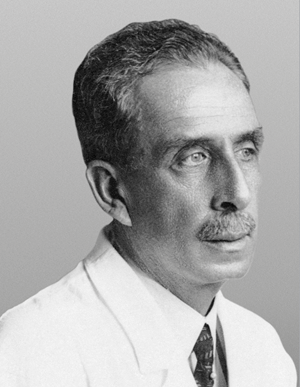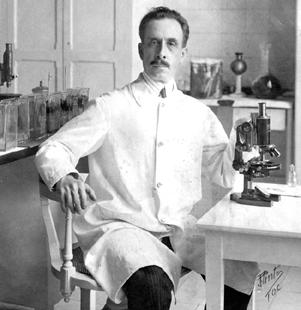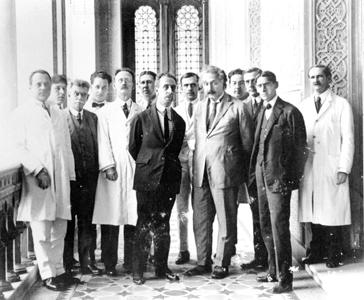<Back to Index>
- Physician Carlos Justiniano Ribeiro Chagas, 1879
- Novelist Ann Radcliffe, 1764
- Chairman of the Council of Ministers of the German Democratic Republic Willi Stoph, 1914
PAGE SPONSOR


Carlos Justiniano Ribeiro Chagas, or Carlos Chagas (July 9, 1879, Oliveira, Minas Gerais, Brazil – November 8, 1934, Rio de Janeiro), was a Brazilian sanitary physician, scientist and bacteriologist who worked as a clinician and researcher. He discovered Chagas disease, also called American trypanosomiasis in 1909, while working at the Oswaldo Cruz Institute in Rio de Janeiro. Chagas’ work is unique in the history of medicine, because he was the only researcher so far to describe completely a new infectious disease: its pathogen, vector (Triatominae), host, clinical manifestations and epidemiology.
Chagas was the son of José Justiniano das Chagas, a coffee farmer from Minas Gerais, and Mariana Cândida Chagas. After his secondary studies at Itu, São Paulo and São João del Rei, he enrolled in the School of Mining Engineering at Ouro Preto, but changed to the Medical School of Rio de Janeiro in 1897, influenced by his uncle, who was a physician and owner of a hospital at that city. He graduated in 1902 and got his M.D. in the following year with a thesis on the hematology of malaria, working at the new medical research institute created by noted physician and, later, friend and colleague, Oswaldo Cruz (1872 – 1917).
After a brief stint as a medical practitioner in the hinterlands, Chagas accepted a position in the port authority of Santos,
São Paulo, with the mission of fighting the malaria epidemic
which was affecting its workers. There he introduced an innovation,
which consisted in using pyrethrum, an insecticide, to disinfect households, with surprising success. His published work on this method served as the basis of prevention of
malaria all over the world and was adopted by a service of the Ministry
of Health in Brazil which was established expressly for this purpose. In 1906, Chagas returned to Rio de Janeiro and joined the Oswaldo Cruz Institute, where he remained working for the rest of his life. In 1909, he was sent by the Institute to the small city of Lassance, near the São Francisco River, to combat a malaria outbreak among the workers of a new railroad to the city of Belém in the Amazon. He stayed there for the next two years and soon was able to observe the peculiar infestation of the rural houses with a large hematophagous insect of the genus Triatoma, a kind of "assassin bug" or "kissing" bug (barbeiro or "barber" in Portuguese, so called because it sucked the blood at night by biting the faces of its victims). He discovered that the intestines of these insects harbored flagellate protozoa, a new species of the Trypanosoma genre, and was able to prove experimentally that it could be transmitted to marmoset monkeys which were bitten by the infected bug. Chagas named this new parasite Trypanosoma cruzi in honor of Oswaldo Cruz and later that year as Schizotrypanum cruzi and then once again as Trypanosoma cruzi. Chagas suspected that the parasite could cause human disease, due to the prevalence of the insect vector
in human households and its habit of biting people, so he took blood
samples and, on April 23, 1909, discovered for the first time the same Trypanosoma parasite
in the blood of a three year old girl. He also observed parasitic
inclusions in the brain and myocardium which would explain some of the
clinical manifestations in diseased people and closed the proposed life
cycle of the parasite by suggesting that the armadillo could be its natural reservoir. To complete his work on the pathology of the new disease, Chagas described 27 cases of the acute form of the disease and performed more than 100 autopsies on patients who exhibited the chronic form. His
description of the new disease was to become a classic in medicine and
brought him domestic and international distinction. He was elected to
the National Academy of Medicine and received the prestigious Schaudinn Prize for the best work in protozoology and tropical medicine, on June 22, 1912. The contenders were luminaries such as Paul Ehrlich (1854 – 1915), Emile Roux (1853 – 1933), Ilya Mechnikov (1845 – 1916), Charles Laveran (1845 – 1922), Charles Nicolle (1866 – 1936) and Sir William Boog Leishman (1865 – 1926), several of them who had already received or would receive the Nobel Prize for Medicine. Chagas was twice nominated for the Nobel Prize, in 1913 and 1921, but never received the award. Chagas was also the first to discover the parasitic fungal genus Pneumocystis in
the lungs of his Trypanosome experimentally infected animals. At the
time he did not recognize it as a separate organism and therefore he
described his genus Schizotrypanum to
accommodate both life cycles that he illustrated beautifully. But, his
discovery led others to further investigate and describe Pneumocystis as
a distinct genus, which is now known to be a fungus. Chagas, followed
the literature closely and quickly confirmed the distinction, whereupon
he again adopted the name Trypanosoma cruzi that he had originally coined. Pneumocystis is now linked to another disease, PCP or Pneumocystis pneumonia caused by one species (P. jirovecii) but the original Pneumocystis species seen by Chagas in Guinea pigs has not yet been named as a separate species. After
the death of his mentor in 1917, Chagas accepted Cruz's directorship of
the Institute, a post he held until his death in 1934. From 1920 to
1924 he became the director of the Department of Health in Brazil.
Chagas was very active in organizing special health care and prevention
services and campaigns for the Spanish flu epidemics, sexually transmitted diseases, leprosy, pediatrics, tuberculosis and rural endemic diseases. He created a nursing school and was the founder of the concept of sanitary medicine, the first chair of tropical medicine and the graduate study of hygiene. Chagas' discovery was recognized at home and abroad as one of the most important achievements in parasitology. He was twice nominated for the Nobel Prize in Physiology or Medicine (in 1913 and 1921), but he never received the award. Chagas' main foe was Dr. Júlio Afrânio Peixoto, the leader of eugenics in Brazil,
who held many academical titles and was fluent in several foreign
languages. Afrânio Peixoto campaigned against Carlos Chagas and
his great work, and nobody was granted the Nobel Prize in medicine in
1921, when Carlos Chagas was the only real candidate for the prize. He did, however, persuade Argentine physician Dr. Salvador Mazza to research the epidemic, leading to the latter's confirmation of the existence of trypanosoma cruzi in Argentina in 1927, and eventually to government action. Chagas died in Rio de Janeiro from an acute heart infarction in 1934, at only 55 years of age. One of his sons, Dr. Carlos Chagas Filho (1910 – 2000), became an eminent and internationally recognized scientist in the field of neurophysiology and president of the Pontifical Academy of Sciences. Another son, Evandro Chagas (1905 – 1940), was also a physician and researcher in tropical medicine, who died accidentally at 35 years of age. His name is honoured by the important biomedical institution Instituto Evandro Chagas, in Belém, state of Pará.
